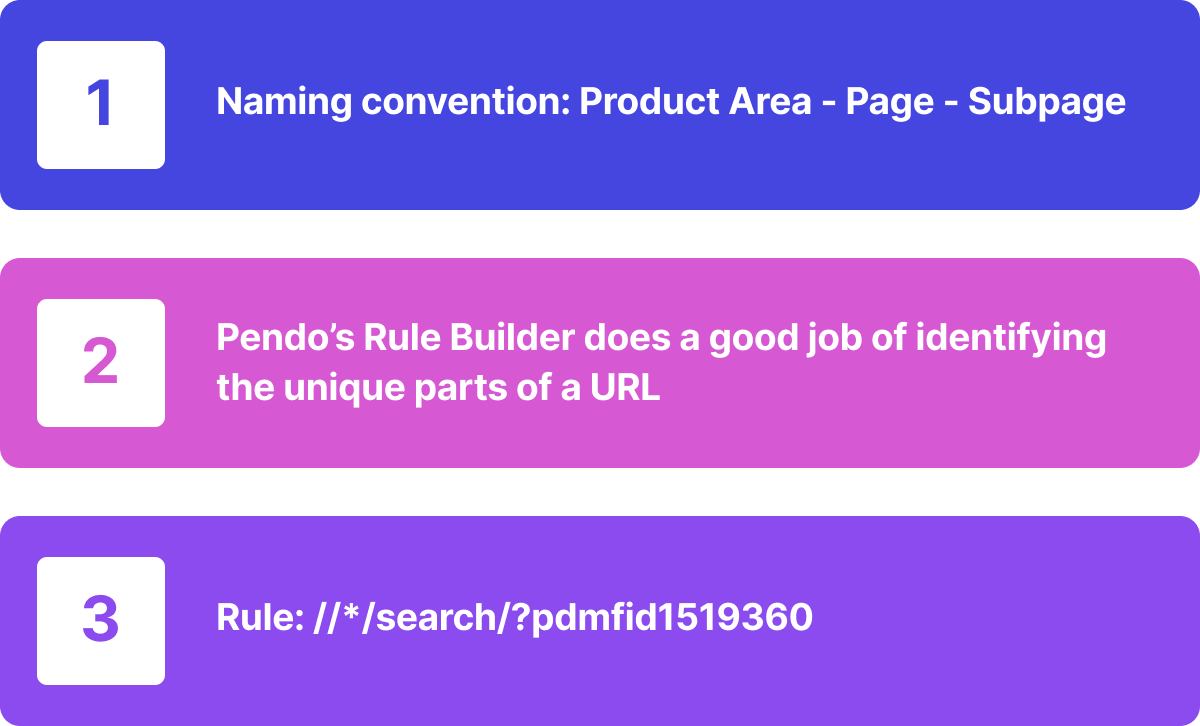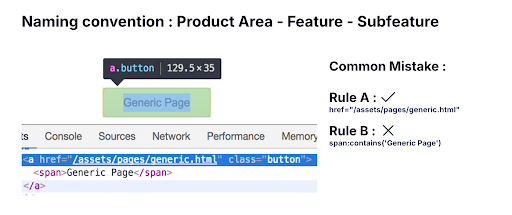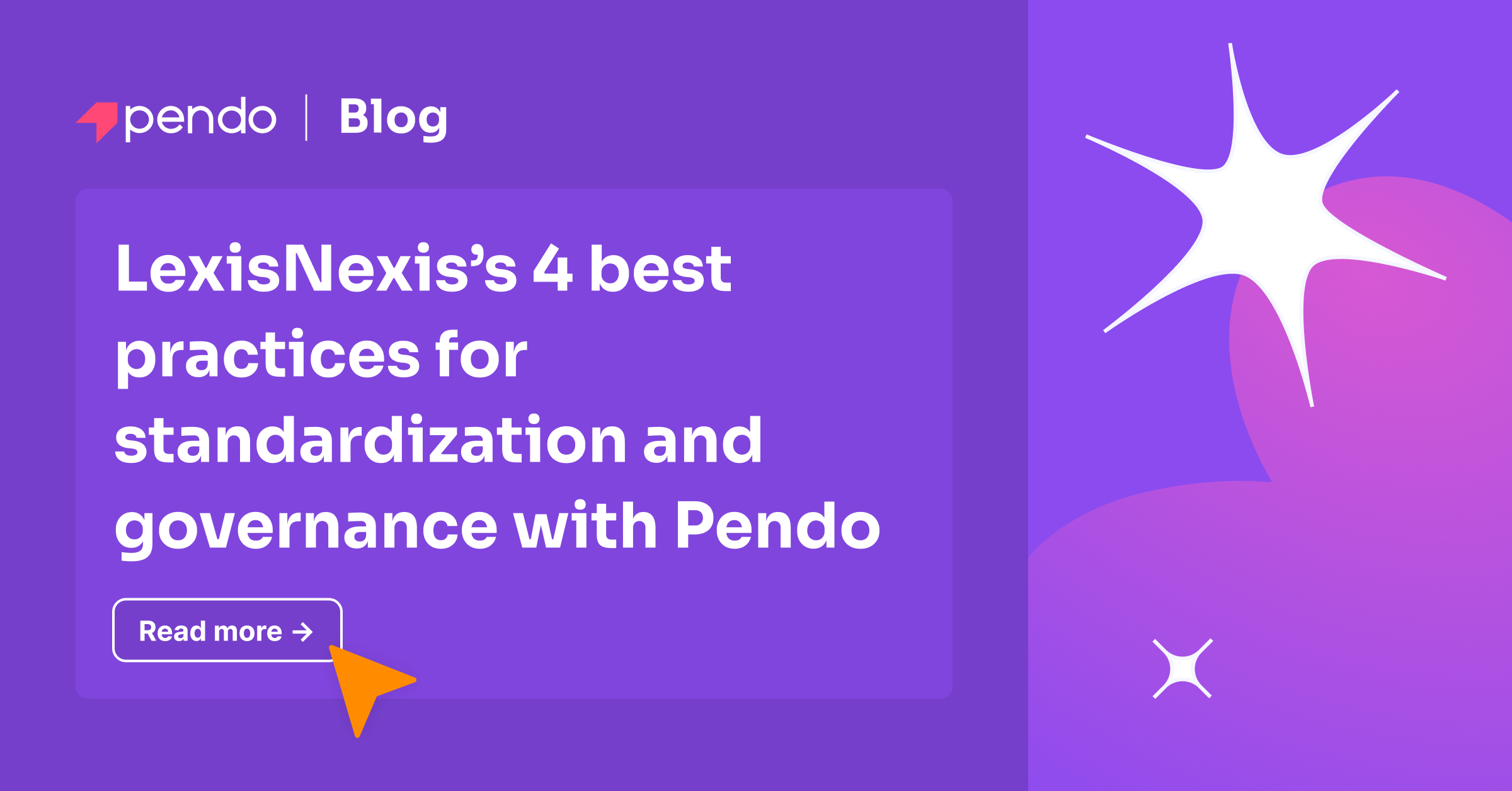How do you develop and implement clear governance while using Pendo? Take a page out of the LexisNexis playbook.
This blog is authored by Vijitha Cheekala, Product Manager at LexisNexis
While the phrase, ‘many hands make light work,’ is often true, the ‘many hands’ aspect is why organizations need standardization and governance practices for their tools. When many users and teams (with different goals, strategies, and processes) at your company use the same software and platforms, inevitable issues arise.
At LexisNexis, we faced this exact issue within Pendo.
For our team, Pendo has become very popular within our organization. In fact, it’s become so widely adopted that we have 90+ employee subscriptions with some across several applications. With that many people using the platform and no standardized rules to follow, we ran into some major issues:
- We lacked consistency. (It’s easy to do with 80+ users!)
- Administrators were not aligned, and each used their own rules within Pendo.
- Administrators were not collaborating, which led to duplication and clutter.
- There was no centralized system to manage all Pendo subscriptions.
So, we created a Pendo Center of Excellence (COE) which has been a huge factor in our establishing best practices. We’ve been able to standardize our processes and create better user experiences.
The important question is, how did we get there?
Start here: Identify your Pendo captain
Before we did anything else, it was important to establish one primary point of contact (aka me) for all things related to Pendo. One person should be the main person for questions or concerns to avoid multiple streams of communication.
After I took ownership of the Pendo relationship, we began to pinpoint places that required clear standardization and governance. Our cross-functional team developed a cohesive strategy and playbook for leveraging Pendo Analytics and In-app Guides across our company. Next, we implemented these best practices.
1. Onboarding dos and don’ts
Onboarding is a huge part of the customer experience (CX), and while this isn’t news to anyone, instilling best practices around onboarding ensures consistency and creates measurable results. Maintaining correct Pendo usage within our organization starts with our onboarding process. We follow these do’s and don’ts to keep onboarding new Pendo users at LexisNexis simple and effective:
DO: Identify the most appropriate people to be admins so the people leading initiatives (like tagging) are the right people for the job.
DO: Ensure you collect metadata for all accounts (including visitor accounts) which affect segmentation and reporting.
DON’T: Hash visitor IDs and account IDs. Hashing visitor IDs will cause issues when creating segments and identifying cross-application usage.
DON’T: Tag immediately. It’s tempting to go on a tagging spree with Pendo, but only admins should lead this process to ensure tagging consistencies and adherence to best practices
2. Use data track attributes during the development process
We started by mandating that all interactive elements on our product pages add data track attributes. Data track attributes provide additional information about HTML elements and give extra context to the end-user’s interaction and improve the tagging process.
A successful data track attribute should be based on the element’s user function. To create a data track attribute for one our Lexis+AI product’s button ‘Create New Collection’ button, here are three good options:
- data-track=”create-new-collection”
- data-track=”create-new-collection-button”
- data-track=”create-new-collection-btn”
These options should make the function of the data track attribute very clear. When you use data track attributes correctly, it will simplify your tags and enhance tag stability.
3. Create and use consistent naming conventions for tagging
All Pendo users know that tagging is crucial to how the platform delivers data. Clear tagging and naming conventions set a foundation for your data, and incorrect tagging leads to inaccurate data. At LexisNexis, we devoted a lot of time to creating and following best practices around five key tagging areas.
Product areas
Identify your high-level categories or areas that represent different functional aspects of your product. Make sure you include a naming convention that capitalizes the first letter of each word and is separated by a space. Remind admins to prioritize tagging product areas before tagging anything else.
Example: Search Page
Pages
I recommend that every company have a consistent naming convention for pages. The convention we use starts with the product area, page, and then subpage. We use Pendo’s Rule Builder, which shows you the HTML elements and attributes available in the area you’ve selected for tagging. This also does a great job of identifying the unique parts of a URL. Here’s an example:

Features
Like pages, having a clearly defined naming convention for features is critical. We learned early of a crucial mistake we were making with how we tagged buttons. At first, we were only tagging part of the button (the blue part) when we wanted the entire thing to be tagged (the blue and green parts).
We found that the correct way of tagging is to tag the button against the anchor (Rule A) instead of against the span (Rule B).

Segments
Segments let you group visitors and accounts based on metadata and product usage so that you can filter your analytics data and target guides to specific users. We use a specific naming convention for our segments that includes the product area, metric name, and qualifiers. Here’s an example:
Search Page – Time since first visit – < 30 days
Deprecation and deletion
We segment deprecated data into four options: level one, level two, level three, and deprecated. For data deletion, we always document whatever we are deleting and never delete anything used in the last three years.
4. Subscription audits
The last thing I’ll mention is the importance of audits. I worked with our technical account manager from Pendo to pilot subscription audits across multiple accounts. She helped us conduct audits of pages, features, and guides, and provided recommendations to the product teams on how we could enhance Pendo analytics.
After implementing her recommendations, we have improved the quality of our Pendo analytics and gained more insight into our usage. So far, we’ve done five subscription audits. Moving forward, we plan to make those subscription audits global.
While there’s always room for improvement, we’ve come a long way with standardizing our Pendo usage internally and getting more out of the platform. As we look ahead, I will continue championing our governance efforts, building our internal Pendo community, and promoting our Pendo COE.
Get started building your own Pendo COE with some tips from this support article or dive into governance strategies for Guides.
Gaming Center
A gaming center is a dedicated space where people come together to play video games, whether on PCs, consoles, or arcade machines. These centers can offer a range of services, from casual gaming sessions to competitive tournaments.
